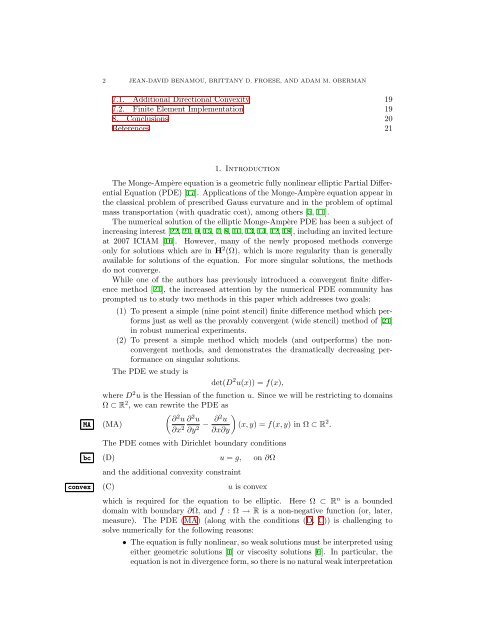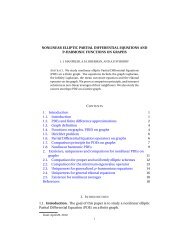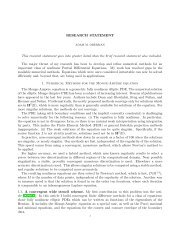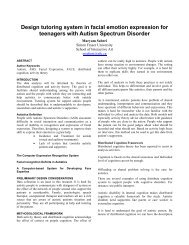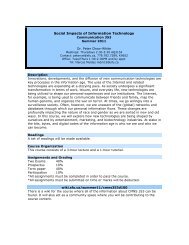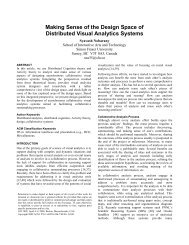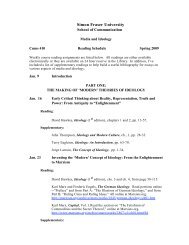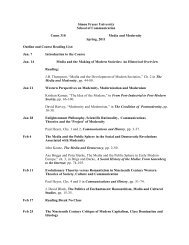2 JEAN-DAVID BENAMOU, BRITTANY D. FROESE, AND ADAM M. OBERMAN7.1. Additional Directional Convexity 197.2. Finite Element Implementation 198. Conclusions 20References 21MA1. IntroductionThe <strong>Monge</strong>-Ampère equation is a geometric fully nonlinear elliptic Partial DifferentialEquation (PDE) [17]. Applications of the <strong>Monge</strong>-Ampère equation appear inthe classical problem of prescribed Gauss curvature and in the problem of optimalmass transportation (with quadratic cost), among others [5, 11].The numerical solution of the elliptic <strong>Monge</strong>-Ampère PDE has been a subject ofincreasing interest [22, 21, 9, 15, 7, 8, 10, 13, 14, 12, 18], including an invited lectureat 2007 ICIAM [16]. However, many of the newly proposed methods convergeonly for solutions which are in H 2 (Ω), which is more regularity than is generallyavailable for solutions of the equation. For more singular solutions, the methodsdo not converge.While one of the authors has previously introduced a convergent finite differencemethod [21], the increased attention by the numerical PDE community hasprompted us to study two methods in this paper which addresses two goals:(1) To present a simple (nine point stencil) finite difference method which performsjust as well as the provably convergent (wide stencil) method of [21]in robust numerical experiments.(2) To present a simple method which models (and outperforms) the nonconvergentmethods, and demonstrates the dramatically decreasing performanceon singular solutions.The PDE we study isdet(D 2 u(x)) = f(x),where D 2 u is the Hessian of the function u. Since we will be restricting to domainsΩ ⊂ R 2 , we can rewrite the PDE as( ∂ 2 u ∂ 2 )u(MA)∂x 2 ∂y 2 − ∂2 u(x, y) = f(x, y) in Ω ⊂ R 2 .∂x∂yThe PDE comes with Dirichlet boundary conditionsbc (D) u = g, on ∂Ωand the additional convexity constraintconvex (C) u is convexwhich is required for the equation to be elliptic. Here Ω ⊂ R n is a boundeddomain with boundary ∂Ω, and f : Ω → R is a non-negative function (or, later,measure). The PDE (MA) (along with the conditions (D, C)) is challenging tosolve numerically for the following reasons:• The equation is fully nonlinear, so weak solutions must be interpreted usingeither geometric solutions [1] or viscosity solutions [6]. In particular, theequation is not in divergence form, so there is no natural weak interpretation
TWO NUMERICAL METHODS FOR THE ELLIPTIC MONGE-AMPÈRE EQUATION 3using integration by parts. This makes the Finite Element Method (FEM)or general Galerkin projection methods unnatural for the problem.• The weak solutions of the equation can be quite singular. Specifically, theyare not in H 2 (Ω). In fact, they may be only Lipschitz continuous 6.1.• The convexity constraint: the solution u must be convex in order for theequation to be elliptic. Without the convexity constraint, this equation doesnot have a unique solution. (For example, taking boundary data g = 0, ifu is a solution then −u is also a solution, in R 2 .)1.1. Related work: provably convergent methods. Two provably convergentmethods have already been presented for (MA).The first, by Oliker and Prussner [22], uses a discretisation based on the geometricinterpretation of the solutions [1]. In two dimensions this method converges tothe geometric solution.The second, by one of authors of this work [21], converges to the viscosity solutionof (MA). While it is not difficult to build consistent, stable numerical methodsfor (MA), this alone is not enough to prove convergence to the viscosity solution. Forconvergence of approximation methods to the viscosity solution, another ingredientis needed, namely monotonicity of the methods [2]. Monotone methods respectthe comparison principle at the discrete level [19]. However, building monotonemethods for this equation requires the use of wide stencils, which come with anadditional consistency error related to the directional resolution of the stencil.1.2. Related work: other methods. There have been a number of other recentlyproposed methods. We emphasise the point that consistency and stability alone arenot enough to ensure convergence to either the geometric or viscosity solution. Inparticular, as explained by Dean and Glowinksi (see below), in the case wheresolutions are not in H 2 (Ω), finite element or Galerkin methods do not converge.Dean and Glowinski et al. [9, 15, 7, 8, 10, 16] have investigated Lagrangian andleast squares methods for the numerical solution of <strong>Monge</strong>-Ampère. The authorsare careful to be clear about the convergence behavior of their methods. In [8] theygive an example of a solution that is not in H 2 (Ω) for which their method diverges.They point out in [7] “if, despite the smoothness of its data, the above problemhas no solution in H 2 (Ω), the above augmented Lagrangian method solves it in aleast-squares sense,” and in [8], “in cases where the <strong>Monge</strong>-Ampère equation underconsideration has no smooth solution, [the methods] provide a quasi-solution”.Feng and Neilan [13, 14], solve second order equations (including the <strong>Monge</strong>-Ampère equation) by adding a small multiple of the bilaplacian. Although notstated explicitly, their method appears to require that solutions be in H 2 (Ω). Thehigher order terms require boundary conditions, and it is not explained how theseadditional boundary conditions are compatible with the solution. They have citeda proof of convergence, but at the time of revision of this work it was not yetavailable.Loeper and Rapetti [18] solve the equation (with periodic boundary conditions)by linearisation and iterate using Newton’s method. They prove convergence of theNewton algorithm for the linearisation of the continuous problem to the solutionof (MA). However, they do not address the issue of the convergence of the discretisedsolution to the solution of the equation in the limit of the discretisationparameter going to zero.


